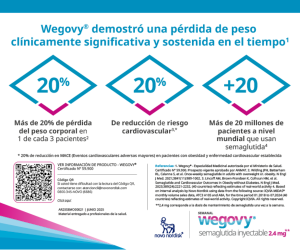Do we combine GLP-1 inhibitors + SGLT2 inhibitors? Yes or no
Keywords:
diabetes, SGLT2i, AR-GLP1Abstract
The sodium-glucose cotransporter-2 (SGLT2i) inhibitors and GLP-1 receptor agonists (GLP-1 RA) share a number of metabolic, cardiovascular, and renal actions that make them an ideal duet for combination therapy. When used in combination, the GLP-1 RAs and SGLT2i correct 7 of the 8 defects that comprise the Defronzo´s Ominous Octet; only the adipocyte insulin resistance is not ameliorated1.
The additive effects of this combination were described in glycemic control, weight loss, reduction in systolic blood pressure, improvements in NAFLD in DURATION-8 (dapagliflozin alone, exenatide alone, or dapagliflozin plus exenatide for 28 weeks). Similar profile on glycemic control was showed in AWARD-10 (dulaglutide plus SGLT2, SGT2 alone) and SUSTAIN -9 (semaglutide plus SGLT2, SGLT2 alone)2.
ADA guidelines recommends in adults with type 2 diabetes and established/high risk of atherosclerotic cardiovascular disease (ASCVD), heart failure (HF), and/or chronic kidney disease (CKD) an SGLT2i and/or AR-GLP1 with demonstrated cardiovascular benefit as part of the glucose-lowering plan independent of A1C, independent of metformin use, and in consideration of person-specific factors3. Emerging data suggest that use of both classes of drugs will provide an additive cardiovascular and kidney outcomes benefit. Evidence to support such an approach includes findings from AMPLITUDE-O (Effect of Efpeglenatide on Cardiovascular Outcomes), Harmony study (Albiglutide and Cardiovascular Outcomes in Patients With Type 2 Diabetes and Cardiovascular Disease) and in a metanalysis of both. Treatment with a AR-GLP1 reduced the risk of adverse cardiovascular events independently of background SGLT2i use without increased risk of serious adverse events3-4. When analyzing combination therapy with SGLT2i and arGLP1we have to consider that data came from drugs that are not available in our country and the data may not apply to patients with advanced HF with reduced ejection fraction, where AR-GLP1 may increase the risk of adverse cardiovascular events. Most data coming from meta-analysis was not able to evaluate potential incremental or additive treatment effects when both drug classes are combined. Concerns about access and cost should be considered when adding treatments. Although a big body of information comes available through the data analysis, clinical trials of these agents and their combination are also needed not only for secondary prevention setting but also for primary to evaluate efficacy and cost-effectiveness.
References
I. DeFronzo RA. Combination therapy with GLP-1 receptor agonist and SGLT2 inhibitor. Diabetes Obes Metab. 2017;19:1353-1362. doi: 10.1111/dom.12982.
II. Brown E, Heerspink HJL, Cuthbertson DJ, Wilding JPH. SGLT2 inhibitors and GLP-1 receptor agonists: established and emerging indications. Lancet. 2021 Jul 17;398(10296):262-276. doi: 10.1016/S0140-6736(21)00536-5.
III. American Diabetes Association Professional Practice Committee; 10. Cardiovascular Disease and Risk Management: Standards of Care in Diabetes 2024. Diabetes Care 1 January 2024; 47 (Supplement_1): S179–S218. doi: 10.2337/dc24-S010.
IV. Neves JS, Borges-Canha M, et al. GLP-1 receptor agonist therapy with and without SGLT-2 inhibitors in patients with type 2 diabetes. J Am Coll Cardiol 2023 Aug 8;82(6):517-525. doi: 10.1016/j.jacc.2023.05.048.
Downloads
Published
Issue
Section
License
Copyright (c) 2024 on behalf of the authors. Reproduction rights: Argentine Society of Diabetes

This work is licensed under a Creative Commons Attribution-NonCommercial-NoDerivatives 4.0 International License.
Dirección Nacional de Derecho de Autor, Exp. N° 5.333.129. Instituto Nacional de la Propiedad Industrial, Marca «Revista de la Sociedad Argentina de Diabetes - Asociación Civil» N° de concesión 2.605.405 y N° de disposición 1.404/13.
La Revista de la SAD está licenciada bajo Licencia Creative Commons Atribución – No Comercial – Sin Obra Derivada 4.0 Internacional.
Por otra parte, la Revista SAD permite que los autores mantengan los derechos de autor sin restricciones.




























